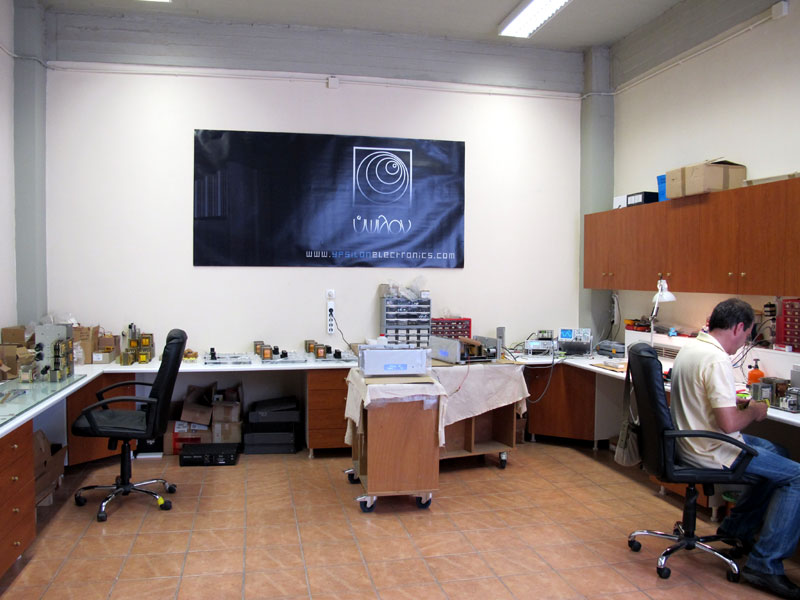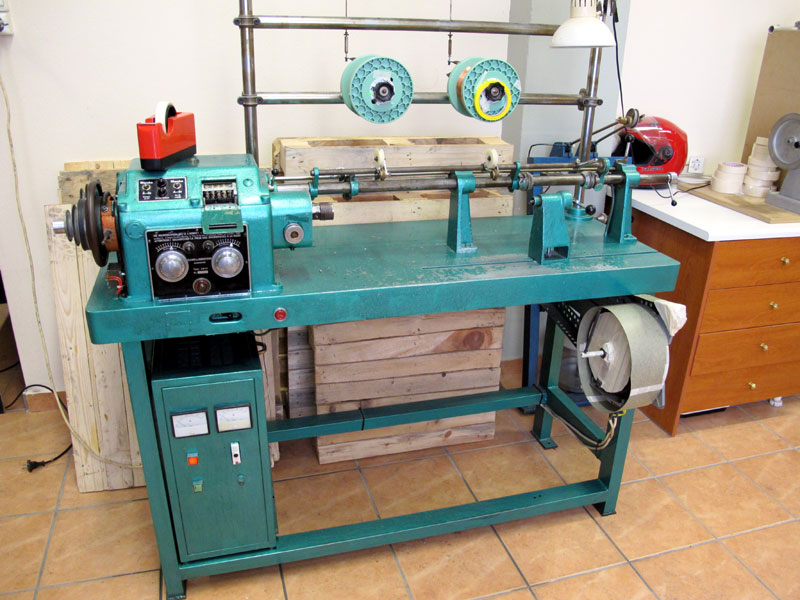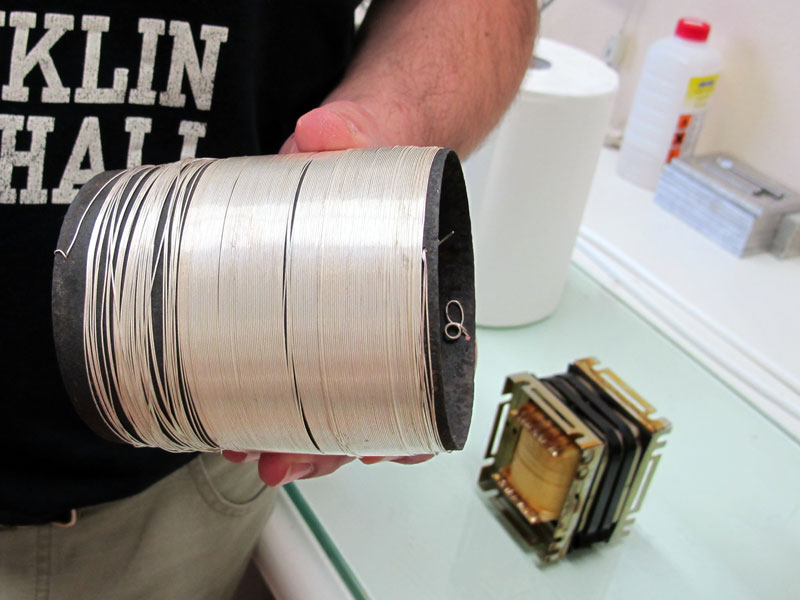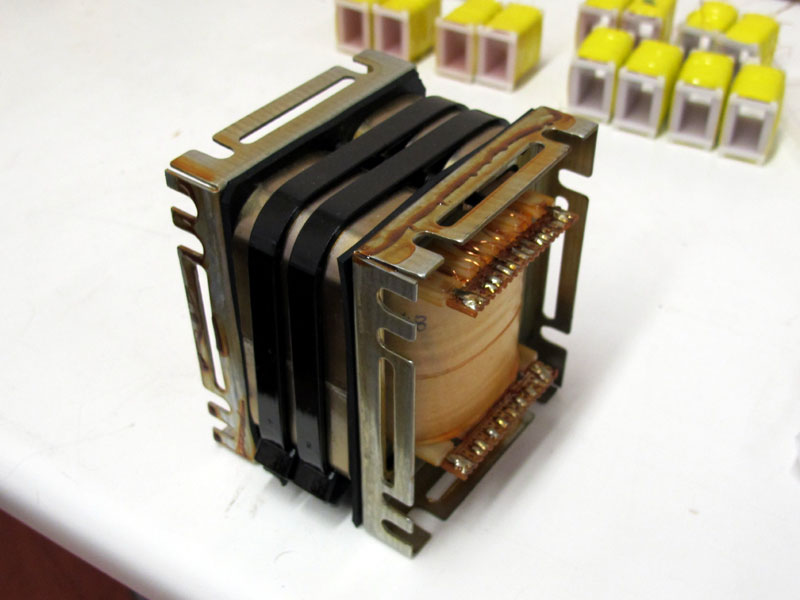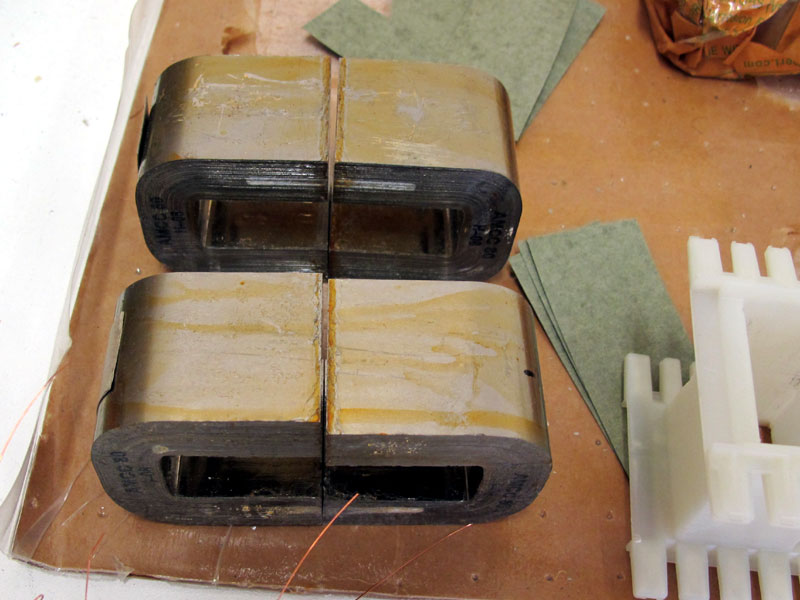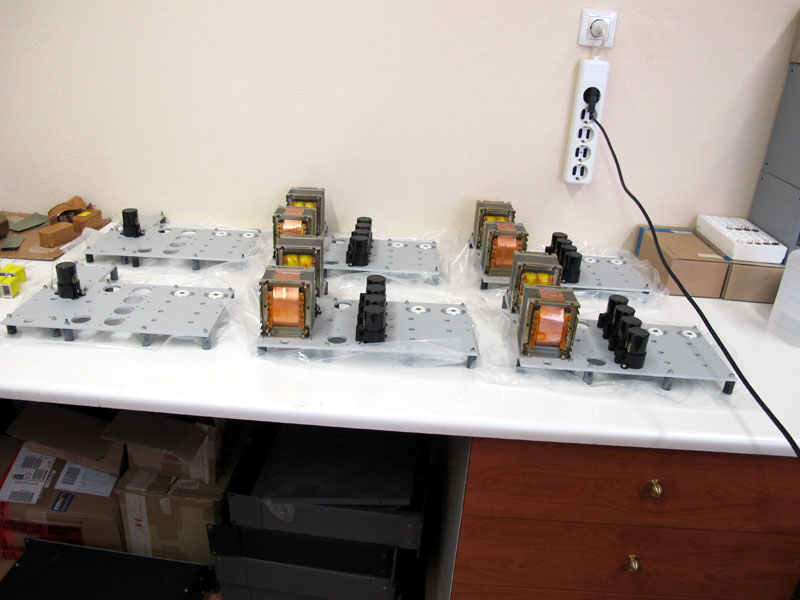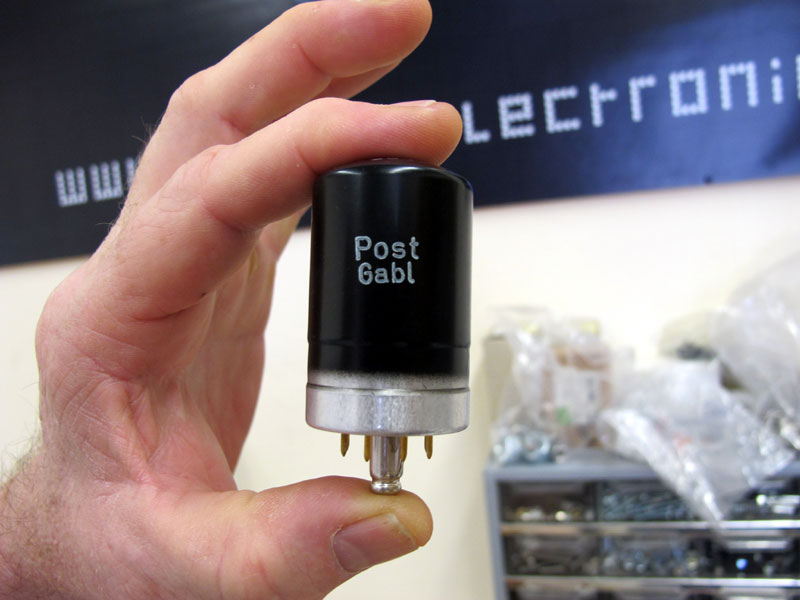A Grecian Formula
ack in the late 1980s -- or perhaps it was the early 1990s, when there actually were nationwide radio networks -- I was invited on a CBS radio network evening talk show hosted by a guy who had an interest in audio. I write "a guy" because his name escapes me. In any case, he asked me to debate informally Stereo Review contributor Ken Pohlmann, who at the time was also the director of the University of Miami’s renowned Music Engineering Program and a digital-audio true believer, on the subject of "analog versus digital." Pohlmann’s position was that CD sound was virtually perfect and certainly better than any form of analog, records in particular. The host was expecting and wanting a food fight, and with me there he got one. This was still in the early days of CD, and if you were around then, surely you remember that the sound was positively dreadful. The converters were primitive, and because the mixing boards were analog, multiple conversions were required even for discs mislabeled “DDD.” Most audiophiles heard how bad the sound was and so did audio manufacturers who tried everything to make the bad sound go away. There were the usual sprays, ointments, rings, green paints, mats, prayer rugs, you name it, all intended to improve CD sound -- none of which in my opinion did much or anything to make it better. Some suggested using massive LaserDisc players as transports, and for a while using an AT&T glass optical cable to route the digits from transport to converter was the panacea. But, truthfully, nothing worked to elevate digital sound to the level of good analog playback. Yes, the digits were quiet, there was no measurable noise or wow and flutter (but there was jitter). What was measured was much better. Unfortunately, what was heard was worse. Much worse. Armed with strong convictions and years of doing both radio and standup comedy, I took on Pohlmann. Let’s just say his technical chops did not trump my polemic abilities. This debate occurred as the Soviet Union was crumbling, so as our hour came to a close, Pohlmann took his best shot: "I bet you’re one of those vacuum tube types too," Pohlmann said derisively. "You know, the Soviets use vacuum tubes in their jet fighters and look where that’s gotten them. They lost the Cold War." "Yes, that’s true," I acknowledged, feigning defeat, "but their planes sound so much better than ours!" [Nationwide rim shot -- and end of debate.] What does that have to do with Ypsilon Electronics? Nothing really, other than that the company is comfortable using both tubes and solid-state devices, sometimes in the same product. I just thought you’d find the story amusing. I first encountered this eighteen-year-old Greek company and its founder and chief designer, Demetris Backlavas, at a hi-fi show somewhere in Europe. Ypsilon first showed in America at CES in 2007, and thereafter Brian Ackerman’s Aaudio Imports quickly picked up the brand for distribution in the US.
Demetris Backlavas hiking in Colorado after the recent Rocky Mountain Audio Fest. Ypsilon is a boutique company that specializes in expensive, handmade electronics that mostly utilize deceptively simple, single-ended, minimal-gain-stage circuitry, though the company also produces a hybrid push-pull power amplifier, a transformer-attenuator-based preamplifier as well as a CD transport and DAC -- and the mighty VPS-100 phono stage. The sound was always memorable wherever I heard Ypsilon gear demonstrated. Of course, when you’re unfamiliar with the associated gear, as is often the case at audio shows, it’s difficult to be sure what’s responsible for the final outcome, but the end result always displayed seamless transparency, an uncanny blend of extension, detail and subtle warmth, and a complete absence of grain, grit and other annoying artifacts. When Mr. Backlavas introduced the $26,000 VPS-100 phono preamp (add $2800 for MC step-up) at CES 2009, I lined up for a review sample, and it demonstrated to me that what I was hearing in those other demos was his sonic-design philosophy that resulted in seamless transparency, an uncanny. . . well, you know where that’s going. Yes, it looked deceptively simple and it was almost grotesquely expensive -- particularly if you just peek inside and see how little seems to be inside -- but there’s no arguing with the sonic results. If someone else can do it for less, I’m all ears. This past summer I was in Greece and arranged to meet Mr. Backlavas at his factory on the outskirts of Athens for a visit and a chat. "Factory" is probably not the right word for the relatively small space. "Assembly point" is more like it, though they do manufacture on premises the transformers that are a key ingredient in the company’s sonic success.
The build area at Ypsilon Electronics. Walk through the front door and you are in a listening room, which is appropriate for a sound-oriented company. In the brightly lit adjacent assembly room one finds a coil winder, a drill press and other manufacturing tools, and on the assembly bench the typical tools of the electronics-manufacturing trade.
The coil-winding machine. The thick, milled aluminum chassis are outsourced, which is common in the industry. In fact, Boulder is the only factory I’ve visited that does all of its metal work in-house. A friend in the jewelry business manufactures Ypsilon’s proprietary solid-silver hook-up wire that’s drawn from solid bars to Mr. Backlavas’s specifications. The transformers are manufactured in-house, though, of course, the cores are outsourced from high-tech companies that specialize in the manufacture of such items.
Ypsilon's specially made solid-silver wire. During the visit, Backlavas, who has a degree in electrical engineering, played for me a new single-ended, single-output-transistor-per-channel design, and he made a point of letting me hear the difference between the amp fitted with the finest-quality coupling capacitor he knows of and with a transformer of his design. The difference wasn’t subtle. In fact, it was pretty shocking, and I don’t have to tell you which was better. Finally I asked him about the phono preamp. Why did it sound so special -- so pure, so detailed, so natural, so extended, so transparent and just plain not there? His answer was long and involved. Fortunately I’d set my iPhone to record it all, and with his kind permission here’s what he told me. The interview begins in mid-sentence. Demetris Backlavas: We need the right components to do equalization with care. I'm not a believer that transformers are the best thing -- or capacitor coupling is the way to go. Transformers have several problems. Michael Fremer: Everything has problems, right? DB: Exactly. Everything has its own problems. I believe that, as a designer, you have to choose always what is best for the job it has to do. So when I started the design of the phono stage, I started with more or less a conventional design, also a two-gain-stage design. The tubes were the Raytheon 5842. It’s equivalent to the 417 from Western Electric. Both 417 and 5842 are great tubes. The 417 is slightly better but not so much better. So I started the design with two gain stages of these tubes and a traditional RC (resistor-capacitor) equalizer network in between the two gain stages, a reasonably good power supply with a rectifier tube and power-supply choke, so it was a very good design. MF: But you say that would be fairly traditional. DB: Exactly. And it also had interfacing problems, because if you want to keep just two gain stages and use this kind of tube, a 5842, the output impedance of this design would be something like 3K [ohms]. So it’s not low enough to drive even one meter of interconnect, and since these interconnects have to be shielded, the capacitance is slightly higher than unshielded interconnect. So 3K ohm was high enough to produce a filter. MF: Yes, and produce high frequency roll-off. DB: Then I started experimenting with LCR circuits, and the next thing I built was the LCR circuit that Tango used to make as a ready module. There are a couple of manufacturers that are selling this kind of LCR circuit that someone can buy and put with a couple of gain stages or even three gain stages. MF: How does that work exactly, an LCR, in layman’s terms? And LCR stands for? DB: L for inductance, C for capacitance, and R for resistance. These circuits are -– we call them T-filters, meaning that they’re not just one component in series and one in parallel. I can draw you the design if you like. They use an inductor in series and they have two resistors in both ends that go through the capacitor to ground. What this T-filter does is that -– it is a filter in a defined frequency, but instead of having varying input impedance and varying output impedance like a normal filter, you drive it with a constant impedance and has a constant impedance. So it’s like the circuit -- is a resistor and the filter itself drives the next gain stage or the cable, like it’s a resistor, without having imaginary parts: inductance or capacitance. And this is very useful because in order to implement a filter in a tube circuit you have to have constant impedance in order not to have variations of the parameters of the filter with time because tubes can change through time. So if you calculate the impedance, the resistance of the tube to be part of the filter, when this part changes then the filter will change. So you need this kind of T-filter in order to have impedance stability with different tube aging. So this kind of filter is immune to the tube variation. MF: Yeah, and also what you’re saying is that the kind that use a standard kind of filter are really susceptible -– the filter is susceptible to changing values as the tubes age. And then when you buy new tubes, is there any kind of guarantee that their characteristics will put the filter back to where it belongs, or could there be variations in that too? DB: It will come back somewhere to the original, but not quite. MF: And this is important for any kind of standardization. The RIAA curve, you’d want it to be -- DB: Exactly. MF: So if we measure your phono section, the RIAA will be within plus or minus -- DB: 0.1, 0.2dB maximum. MF: Yeah, that’s good. DB: I usually adjust the accuracy of the curve lower than 0.1dB, but I have calculated with tube aging not to be higher than 0.2dB. One pole is formed with just an inductor and the other two with T-filters. I’m jumping now but -- MF: Yeah, I’m sorry. I should have let you finish.
DB: But anyway, better we take it step by step. Anyway, I was saying I tried this kind of LCR filter. The most usual is a T-filter, that is working in 600-ohm impedance. And you need two of these T-filters. One is for 50Hz and 500Hz poles and the other is for 2kHz. So you need two inductors that in this particular 600-ohm implementation. They both have to be core-based inductors, so there is an issue there with the core properties. It’s better to make a small departure here about what happens with the core properties. Magnetic materials that we are using for transformers have some different properties depending on the material. For example, the standard silicon steel, three-percent silicon steel material that most of the EI cores are made of (so named for the shape of the two core components) or the big toroidals, small toroidal small power supply, the core material is three-percent silicon steel. The standard one is in half of a millimeter of thickness, and this is probably the worst material. It has a lot of losses, and losses -– it’s not that we are losing energy; it’s that they have a wide hysteresis curve, meaning they store energy, then release it. So when you produce a magnetic field in such a material and you cut the field, if it’s a DC magnetic field, when you cut it normally the material has to stop to be magnetized. These kind of materials, they will still be magnetized. Also the magnetic permeability is a term similar with -– it’s the equivalent in electric current of conductance. The magnetic permeability in very low flux is very low, meaning that in order to magnetize the core, some part of the signal is lost in order to "wake" the core. Another material that was used from nearly the beginning of the century was nickel cores, low-nickel cores or high-nickel cores, meaning 35 percent or 49 percent nickel, or high nickel cores is 79 percent nickel. They contain other metals also. MF: Who is sitting around saying to you, "Let me try a nickel core and see how it works?" Who is doing that kind of work? DB: With nickel? Who designs with nickel cores? MF: Yes, and who is sitting around saying, "I’m going to design a transformer using a nickel core and see how that -- " DB: They were trying all sorts of materials back then. MF: Who is "they," though? These were people from the audio world? DB: Yeah, nickel cores, if I’m not wrong, started when they wanted to make transformers for the line from UK to US. MF: The transoceanic phone line. Okay, so that’s the whole point. DB: I think Sowter [G.A.V. Sowter] had made pioneering work with nickel. MF: Who? DB: Sowter of Sowter transformers. MF: Oh, okay. DB: It’s still in existence -– a top name in transformers in the UK. MF: So is there an analogy to be drawn between the black art of tube making, which has kind of disappeared, and the transformer art? DB: Not really. With today’s materials we can build much better transformers today than we could in the old days. To continue my thinking, the nickel core has much better properties than standard silicon, but still it’s not the best available material. My previous preamplifier with the transformer attenuator was using 79-percent nickel core. Also one important parameter in the core, these cores, these high-performance cores, are coming usually in C-core shapes, meaning -– I can show you. MF: I saw that in there [the assembly area]. They looked like a "C" shape. Two of them coupled together.
Transformer C-cores. DB: Yeah, two. It’s a core that is made with a tape that is wound, insulated, and glued together, and then they cut and mill the gap in order to be perfectly -– one half to be perfectly touching the other. So I was using nickel core in the transformer attenuator. Nickel cores have a character that I ended up not liking anymore. MF: A sonic character? DB: A sonic character, yes. MF: Because the people designing it were not thinking about sound, right? They were thinking of something else. It was the telephone. DB: Generally nickel cores were used for audio and for all kinds of different uses. MF: But they didn’t design them to think about the sound characteristics of them. It just happened to have a certain character that you found you didn’t like. DB: Exactly. And this character has to do with the properties. I mean how the magnetic permeability is changing with flux. Also, how it’s changing with frequency. And how wide is the hysteresis loop and how high are these losses. The losses are the integration of the hysteresis loop -- you know, the B-H curve [a graphical curve showing the relation between magnetic induction, B, and magnetizing force, H, for a magnetic material, also known as magnetization curve]. And if you do an integration in this loop -- I can show you in my computer what it looks like -– is what we call the losses of the core. And these losses also change with frequency. In high frequencies, these losses become higher. Also, one important parameter of these cores is the thickness of this tape. The lower we go in thickness, the lower the losses are in high frequencies. So the traditional silicon steel comes in half of a millimeter thickness. You can find good-quality, grain-oriented silicon steel in .03 0.3 millimeter, around .03 0.3, and these nickel cores can come in .03 0.3, .01 0.1, and in C-cores they can be 80 microns or 50. The lowest they can be manufactured is 25 microns, something like 1000th of an inch thickness. This is four times thinner than a plain sheet of paper. And in these very thin cores the magnetic properties are very good, the losses are very low in high frequencies, and they are also very linear. The magnetic permeability with frequency and with flux, varying flux, is very linear. Anyway, we were discussing nickel. MF: It sounds like you didn’t use a nickel core. DB: I was using them in the first version of the preamplifier, and then I changed to amorphous alloys, which are more more high-tech materials. Amorphous is based on ferrite and comes only in very low thickness, around 1000th of an inch, and can be constructed only in C-cores or small toroidals. There is also a cobalt-based amorphous material. This material has perhaps the best magnetic properties -- very linear magnetic permeability with frequency and flux, very low losses. It can be used in very high frequencies. And there is also another amorphous material called nano-crystalline, but the structure of this material is not in an amorphous state. The amorphous has small and big parts. That’s why we call it amorphous. The nano-crystalline has only nano parts. The nano-crystalline is also a ferrite-based material. These materials have much better linearity of magnetic permeability with frequency. You see, nickel core, if you see this curve, permeability versus frequency, is like a bell-shaped curve. Amorphous and nano-crystalline are flat, and in these materials the initial permeability, meaning when we start to excite the core, is very high. So the signal is not lost trying to magnetize the core. Now I’m using only amorphous-based materials. MF: Is that based upon both the specs as you got them and then listening, or was just the spec was sufficient? DB: I listened to all kinds of materials: low-nickel, high-nickel core, amorphous, ferrite-based, nano-crystalline from different manufacturers. I chose the best material for the job it has to do. DB: I make custom sizes with custom magnetic properties. Also, I forgot to tell you this. With some materials, you can do annealing -- heating and cooling of the core -- and you can have different magnetic properties, how high the magnetic permeability would be, or if you want a flat loop, flat hysteresis loop, or round loop, or even a square loop, but square loop is not useable for audio! I order and they make these materials for me in a factory in the US. I found that they are the best in making cores. They have very good quality control. They reject cores if they are shorted. You see, they have to be insulated. And also the milling in the gap is nearly perfect, less than ten microns. I can show you ready-made amorphous cores bought from a manufacturer, and if you see it in the light and you see the gap, you can see that they’re touching in one point but not in all of the surface. So these kind of cores can be used in single-ended circuits when we use DC current through them where we want to have a specified gap. But they are not useable in the preamp’s transformer attenuator, for instance. There we have to have a perfect touching between the two halves of the core. So, to come back to your question, I look at the specs, I always see the different technical properties of the materials, but the end decision is made with listening. MF: Of course. So what’s in the phono section?
A half-dozen partially finished Ypsilon VPS-100 phono stages. DB: One more thing is that actually I started designing electronics and I was building amplifiers 20 years ago. I began with designs, the usual solid-state designs -- MF: This is when you were a teenager, 20 years ago? DB: Yes, exactly. I started designing amplifiers since I was something like 20 years old. I started with traditional solid-state designs and tubes at the same time, and I started also in technical university. I studied a lot about transformers. I’m still learning about them, and I’m still studying them. But at that time I didn’t make amplifiers using transformers. I was using the known theories about amplifiers. I ended up with transformers through all these years of evolution in designing and trying to make things sound better, and simpler, and at the end I found out that a good transformer sounds much better than a good capacitor. So perhaps we can, if you are interested -- we can do this in the small amplifier, we can put the silver-foil capacitor, listen to it, and then put the transformer and see exactly the character of both components. [We later did that, and the differences between the excellent and expensive silver-foil capacitor and the transformer were considerable -- in favor of the transformer, of course.] MF: That sounds interesting. DB: This is very instructive if you listen and understand the character of these components, it’s very instructive and can lead you then to the design of the phono stage. If you see what the capacitor does to the signal, the coupling capacitor, when it’s used in a filter, for example in a phono stage, then it’s ten times worse. This is because a capacitor, when it’s the coupling capacitor, the voltage between the two ends of the capacitor is zero. The impedance of the capacitor there is very low, but when you’re using it as a filter, the AC voltage in each end of the capacitor is not zero. It is high. The impedance of the capacitor is higher. So there the capacitor works much worse than it works as a coupling capacitor. So if you listen to what the capacitor does to the signal as a coupling cap, multiply this by ten and you’ll have a good idea of what it does when used in an RIAA filter. MF: So it’s in there to roll off the top end in the RIAA? Or what is it used for? DB: Yes. In a traditional RC, we use actually two filters combined together, two RC filters, and they do the RIAA curve. Anyway, to get back to the design of the phono stage, after I tried these LCR filters, I clearly understood that this was the way to go, and I built a circuit with two gain stages and the LCR circuit at the output. This kind of design is already been made by a couple of Japanese manufacturers. MF: And they weren’t put into wider use because implementation was too expensive or too difficult? Or it didn’t become more popular because -- DB: I think Zanden is making an LCR phono stage. Who else? And WAVAC also does an LCR design. MF: I liked the Zanden a lot when I reviewed it, but it sounded very soft compared to yours, and romantic, and not -- DB: After this design, I tried various different tubes, and I immediately understood that in order to have this design only with two gain stages, I needed very high-technology tubes, and not the usual 6922 or 12AX7 and the usual stuff. Otherwise, the design had to be three or four gain stages, and a lot of transparency and involvement would be lost.
The Siemens military tube used in the VPS-100. So what I wanted was that -- I wanted it all, in fact! Meaning that I want only two gain stages, I wanted enough gain, but low enough output impedance to drive the next component in the chain. And this, it wasn’t easy, since if you have an LCR design it’s better to operate the LCR at 600 ohms or lower. They can be designed higher in impedance, but the coils then are very difficult and probably impossible to build because of parasitic capacitance in them, which you can avoid. So it’s easy to make two gain stages with CR. With an LCR, it is more difficult because you have to drive the LCR. Tubes cannot drive 600-ohm impedance, so you need an additional gain stage to drive the LCR. But I wanted two gain stages. That’s why I started searching every kind of tube. |


